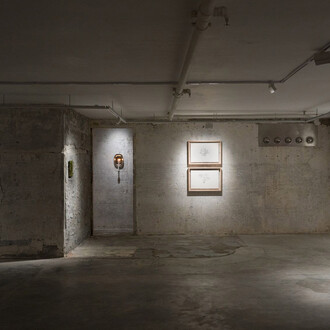Alisan Fine Arts, Central Gallery is pleased to announce the opening of a groundbreaking group exhibition, titled Word play, on September 19, 2024. Centered around the expression, investigation and deconstruction of Chinese characters, this carefully curated exhibition invites the audience into a compelling journey of contemporary Chinese art through “wordplay”. Across pure calligraphy, sculptural experimentation, AI-assisted creation, word formation and abstraction, the show features works by 19 artists across different generations: Chu Chu, Chui Tze-Hung, Chui Pui-Chee, Fung Ming-Chip, Gu Gan, Gu Wenda, Hao Shiming, Hon Chi-Fun, Pat Hui, Hung Keung, Kan Tai-Keung, Li Huasheng, Ren Tianjin, Fabienne Verdier, Wang Dongling, John Way, Wei Ligang, Wucius Wong, and Xu Bing. In four distinctly thematic galleries - Contemporary Calligraphy, Composing with Words, Word as Image, and Abstraction, artists from diverse historic and cultural backgrounds contribute their unique “play on words,” with works selected from a period of 40-plus years since the 1980s. The written word - long considered the essence of Chinese culture - continues to serve as the point of departure for both faithful emulation and radical innovation in contemporary art, and is at the heart of this not-to-miss exhibition.
Contemporary Calligraphy
(7 artists: Chui Pui-Chee, Fung Ming-Chip, Gu Wenda, Hon Chi-Fun, Li Huasheng, Ren Tianjin, Wang Dongling). The entry gallery is devoted to the evolution of various calligraphic scripts through the mesmerizing brushwork of seven artists. The eminent master calligrapher Wang Dongling, known for gestural interpretations of traditional scripts and pushing the expressive lines beyond paintings’ edges, will present a “Formless Cao Script” work, a continuation of his signature style inspired by the winter scene of the withered lotus pond at the storied West Lake. A never-before-seen early seal-script calligraphy by Li Huasheng (1944 -2018), of the same generation as Wang, offers a rare glance into the future of the artist’s more recognizable abstract ink paintings. A monumental couplet by the celebrated contemporary artist, Gu Wenda, is an exquisite example of a later fully-developed language of appropriating traditional ink painting and stone steles into large-scale conceptual installations. Two of Wang’s students are featured as well: Ren Tianjin’s three-dimensional rendition of the word “East Garden” (東園) - an echo of the 8-foot-tall sculpture standing at the entrance of the Asian Art Museum of San Francisco; and Chui Pui-Chee’s calligraphy that seeks to embrace contemporary lifestyle and his personal fascinations by incorporating Cantonese pop song lyrics and alternative materials such as wine and whisky. Additionally, works by Fung Ming-Chip, a modern calligrapher who has developed over one hundred new scripts, and Hon Chi-Fun (1922-2019), a revered visual artist who co-founded the modernist collective, the Circle Art Group in 1963, are also included.
Composing with Words
(5 artists: Chu Chu, Chui Tse-Hung, Hung Keung, Pat Hui, Wucius Wong). The artists in this section inherit the Chinese literati ideal of “poetry within painting” while incorporating contemporary elements such as AI, geometric form, and gestural expression. Featured artists include three students of the New Ink Movement pioneer, Lui Shou-Kwan(1919-1975): ink master Wucius Wong who famously combines geometric form and mountainscape in his paintings; painter, critic, and educator, Chui Tze-Hung whose works strike a delicate balance between vibrant abstract colour blocks and expressive cursive script; and Pat Hui who inscribes Tang and Song dynasties’ poems on top of her abstract landscapes. Provocatively, an early ink work by calligrapher and photographer, Chu Chu, and a digital work by the multi-media artist Hung Keung are presented side by side, both drawing inspiration from the Heart Sutra Buddhist text and the image of flowers.
Word as Image
(4 artists: Gu Gan, Kan Tai-Keung, Wei Ligang, Xu Bing). In this section, four artists unlock their visual linguistic imagination and offer radically exciting expressions of the Chinese word. The world-renowned conceptual artist and the newly appointed Ambassador of Cultural Promotion for Hong Kong, Xu Bing literally “writes” the landscape in his Landscript masterpiece, forming mountains with the Chinese character for “stone” (石), expanses of “wood”(木) and “tree”(樹) characters. We also feature an important painting by Gu Gan (1942-2020), considered by many as the forefather of the Modern Calligraphy Movement in China; in the painting, Gu re-composes the word “forest”(林) to form a charming tableau of moonlit forest. Following Gu’s footsteps, the 2005 Asian-Cultural-Council-Fellowship Grantee, Wei Ligang offers his innovation in “Wei Squares'' characters in which individual characters are deconstructed and reformed within the boundaries of a square shape, while maintaining their roots in ancient script rules. Additionally, Kan Tai-Keung, a student of Lui Shou-Kwan, conjures tranquil realms and cloudscapes by ingeniously incorporating cursive brushstrokes into his ethereal mountains, pine trees, and waterfalls.
Abstraction
(3 artists: Hao Shiming, Fabienne Verdier, John Way). The final section highlights the bold experimentations of abstraction based on the Chinese word, through works of three remarkable artists who unleash the dynamic and expressive quality of the brushstroke in ink and beyond. We feature powerful calligraphic paintings by the Chinese-American artist John Way (1921-2012), in which influences of Abstract Expressionism and Chinese calligraphy collide through thickly applied acrylic paint. Fabienne Verdier, a well-known French abstract artist today, was the only foreign member admitted to the National Calligraphers’ Association in China after her decade-long arduous learning journey in the country. Her limited edition serigraph print encapsulates her profound effort in condensing the complexities of the Chinese word into a form of essence. On the contrary, emerging Beijing artist Hao Shiming deconstructs characters into writhing lines and interweaves them into an ever-growing web of character-strokes. A sculptural rendition of his interwoven lines will be on display for the first time as well.
















